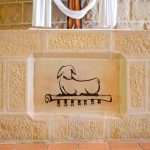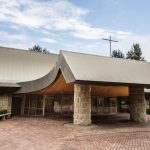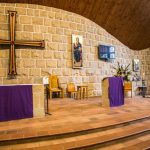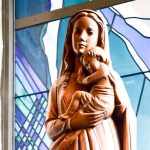Who We Are
and what we do
Where it all began
Until 1911, Catholics in the lower mountains worshipped at Penrith. Then in 1911, the re-routing of the railway line round Glenbrook brought with it a large number of workers and their families.
To begin with, Mass was said on week mornings in a cottage occupied by Fr James Sheridan, (Parish Priest of Penrith 1892-1900), on the site now occupied by the RAAF at Lapstone.
Mass was also said in the home of Mr and Mrs Wood and in the Glenbrook School of Arts. St Finbar's Church was built by Fr Thomas Barlow (Parish Priest of Penrith) at a cost of £200-£300 ($400-$600).
The church was blessed and opened by Archbishop Michael Kelly in August 1912. The architect was Mr Charles Fowler. Mr Norrie donated the land for the church and Mr Nolan donated the Stations of the Cross.
Parish Priests & Administrators
Until 1911, Catholics in the lower mountains worshipped at Penrith. Then in 1911, the re-routing of the railway line round Glenbrook brought with it a large number of workers and their families.
To begin with, Mass was said on week mornings in a cottage occupied by Fr James Sheridan, (Parish Priest of Penrith 1892-1900), on the site now occupied by the RAAF at Lapstone. Mass was also said in the home of Mr and Mrs Wood and in the Glenbrook School of Arts.
St Finbar's Church was built by Fr Thomas Barlow (Parish Priest of Penrith) at a cost of £200-£300 ($400-$600). The church was blessed and opened by Archbishop Michael Kelly in August 1912. The architect was Mr Charles Fowler. Mr Norrie donated the land for the church and Mr Nolan donated the Stations of the Cross.
Father Danny Fay
30 March 1965 - 11 October 1990
The Parish of St Finbar's, Glenbrook was established on 30 March 1965 and Fr Danny Fay was appointed its Parish Priest. Under his guiding hand, a new church/hall was built and blessed and opened on the Feast of the Immaculate Conception 8 December 1966 by Rt Rev Monsignor Thomas Veech, then Rector of St Columba's Seminary, Springwood. Fr Danny Fay was farewelled on 8 July 1990, and Fr Alex Sciberras became administrator of the parish.
Father Alex Sciberras (Administrator)
July 1990 - 30 June 1991
Father Brian Larkey
23 July 1991 - 31 December 1996
Fr Brian Larkey was appointed as Parish Priest in July 1991, and was responsible for having the new church of St Finbar's built and the dedication took place on 7 May 1995, the ceremony being conducted by the Most Rev Bede V Heather, DD, LSS., first Bishop of Parramatta. Fr Larkey was also instrumental in installing the beautiful pipe organ, which was formally inaugurated on 15 October 1995.
Father Arthur Cook (Administrator)
Jan-Feb 1997
Father Peter Dowd
1 March 1997 - 10 August 1999
Father John McSweeney
16 August 1999 - 16 August 2012
Fr John McSweeney was appointed Parish Priest on 16 August 1999 and was officially installed by Bishop Kevin Manning, the second Bishop of Parramatta, on 5 September 1999. During Fr McSweeney's absence on continuous full-time duty for the Royal Australian Navy in 2003, Fr Kevin Lee was Parish Administrator for nine months from April until December. Fr John was reappointed Parish Priest for a further six years in August 2005.
In August 2006, work commenced on a new presbytery with completion in April 2007. Bishop Kevin Manning blessed the new residence in March 2008 and Fr Maurice McNamara moved into the downstairs unit after his retirement from Windsor Parish in April 2008. During Fr John's long-service leave in 2008, Fr Joseph Thomas was administrator. In 2012 the parish undertook the renovation of the parish hall (the original Church built by Fr Fay).
Father Kevin Lee (Administrator)
April - December 2003
Father Joseph Thomas (Administrator)
September - November 2008
Father Wim Hoekstra
16 August 2012 - 31 January 2015
On 16th August 2012 Fr Wim Hoekstra was appointed as the new parish priest of Glenbrook and Fr McSweeney was transferred to become Parish Priest and Dean of St Patrick's Cathedral, Parramatta.
Fr Wim was installed as Parish Priest on 18 November 2012 by Most Rev Anthony Fisher OP, the third Bishop of Parramatta, who also blessed and officially opened the Father Thomas Barlow Centre, the original church built in 1912 which had been renovated by St Finbar's School.
In April 2014, Fr Wim also took over as Administrator of Our Lady of the Way Parish Emu Plains, pending the appointment of a new Parish Priest.
Father Porathur R Joy MS (Administrator)
1 February 2015- April 2015
Fr Porathur Rappai Joy ms, aka Fr PJ, was appointed as Assistant Priest to Glenbrook from August 1, 2014, and together Fr Wim and Fr PJ have shared the ministry of St Finbar's and Our Lady of the Way Parishes.
On 1 February 2015 Fr Wim took up his new appointment as Administrator of the Parish of Baulkham Hills, and Fr PJ was appointed as Adminstrator of St Finbar's.
Father Jolly Chacko MS
18 April 2015- 13 October 2020
On 18th April 2015 Fr. Jolly Chacko m.s. was appointed as Administrator, and then as the new Parish Priest of St. Finbar's.
Father Joe Lam OSA
14th November 2020 - current
Parish Team
Fr Joseph Lam
Parish Priest
Juliana Khnouf
Parish Secretary
Peter McMahon
Parish Administration
Our Patron Saint
St Finbar
The patron saint of our Parish is St Finbar (Finbarr) whose feast is celebrated on 25 September. Finbar's birth is given as 570AD and Muskerry, Cork, Ireland given as the birthplace.
The country at this time was undergoing great expansion, especially of Christian churches and monasteries. Finbar founded the See of Cork and as a result was made a Bishop.
Finbar worked hard among the people to spread the faith. It is thought that St Finbar began his monastic life on a little island in the lake of Gougane Barra.
As well as a monastery, Finbar established a "great school of learning" which continues even to this day.
St Finbar died in 630AD and he is buried within the enclosure of the monastery he established.
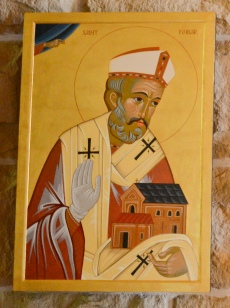
Our Church
Symbols
Church Plaque
One of the inscriptions on the bronze plaques attached to the front of the church refers to the building as a temple and the other as an "ecclesia", in English "a church". Read more using the button.
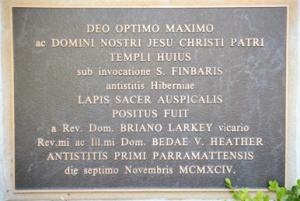 One of the inscriptions on the bronze plaques attached to the front of the church refers to the building as a temple and the other as an "ecclesia", in English "a church".
One of the inscriptions on the bronze plaques attached to the front of the church refers to the building as a temple and the other as an "ecclesia", in English "a church".
While the use of the word "temple" calls to mind our religious heritage stemming from the Jewish temple in Jerusalem, the language of the inscription draws heavily on the Roman tradition and especially on the inculturation of the Judeo-Christian religion into the traditional Latin and Roman religious experience.
When the Christians were given civil rights in the fourth century, they adopted many of the common Latin words to describe their officers and practices instead of importing Greek or Jewish words. Contemporary studies of the origin of the Hebrew Bible and Jewish religious practices reveal that the early Israelites also borrowed heavily from the middle Eastern culture of which they were part, even though they condemned many of its practices as an unsuitable expression of true religious experience.
The foundation stone is described as sacred and auspicious. Those who have been to an Italian wedding have, no doubt, been puzzled as to why a little bird is released from a cage on the top of the wedding cake when the cake is cut. In Roman times the state official who officiated at a wedding was called an "auspex" which literally means "a bird-watcher" since it is a contraction of the words "avis" and "spectator" from which comes our English word "aviary" etc.
He was so known because this official also watched birds at weddings because he or she claimed to be able to predict the future of the marriage from the manner of the bird's flight. It was a kind of soothsaying and certainly unscientific but it was probably as effective as any contemporary and "scientific" method of foretelling, for example the future development of the Australian economy.
The Romans, therefore, saw the beginning of significant events in their lives as important occasions in which to seek divine guidance and blessing and to pray for the successful outcome of the project. And so it was that when the first stone of the new church was laid, prayers were made that it would be successfully completed, etc.
The adjective "auspicalls" means more than our English word "auspicious" having the sense of "momentous" and "significant for the future". The translation is expanded in English to read:
"The auspicious and sacred stone of this temple, belonging to the most gracious God and Father of Our Lord, Jesus Christ and dedicated in remembrance of the Irish Bishop St Finbar, was put in place by Rev. Brian Larkey acting as delegate of the most Reverend and Illustrious Bede V Heather, First Bishop of the Diocese of Parramatta, on the seventh of November, 1994".
The Latin word used in the inscription and translated as Bishop is "Antistes". In ancient Rome an "antistes" was the president or chief priest of a temple. The word also had the sense of "an overseer" and has as its root the word "stat" and in English "stand". As time progressed, however, the president of a Christian church became as "a bishop" which derived from a Greek word with the same sense, namely "overseer". This inscription then reflects the cultic aspect of religion and reveals the ancient Roman influence in our religious heritage.
The other plaque reflects the pastoral nature of the Christian faith. Following precedents in the Hebrew Bible, Jesus referred to Himself as the Good Shepherd who never leaves His flock untended. He calls it together and presides over it. He seeks out the one that is lost. The church in this imagery is the sheep-fold.
With this imagery foremost in our imagination, the new church can be seen as continuing the synagogue tradition. This is the place where the Bible is read, and commented upon, and prayers are offered as distinct from the Jerusalem temple from which derives the cultic aspects of our religious heritage.The inscription may be translated as follows:
"On the seventh of May, 1995, the Most Reverend and Illustrious Bede V Heather, the first Bishop of Parramatta, consecrated this church to which Our Lord, Jesus Christ calls together His flock, and placed it under the patronage of the Irish Bishop, St Finbar."
Main Doors
The main doors of the new church are decorated with certain symbols after the manner of the doors of the great churches of Europe. Read more using the button below.
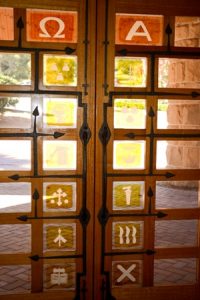
The main doors of the new church are decorated with certain symbols after the manner of the doors of the great churches of Europe.
On the centre wooden doors, the symbols designate the twelve apostles upon whom Jesus Christ founded His Church.
Linking the glass panels, upon which the symbols are sand-blasted, are some iron tracery in the form of a vine. This recalls the words of Jesus to His disciples, "I am the vine and you are the branches".
These symbols are on the door in order to remind us as we enter the portal of the church that our religious roots stretch back in a line of apostolic succession from Bishop Bede Heather, and Pop John Paul II to the original apostolic college.
The explanation of the symbols is as follows:
The Greek letters at the top namely, alpha and omega, are to be found in the Apocalypse 1:8 and 21:6.
The usage there is that the quality of God as the originator of all things is shared with Christ as the Risen Lord. On the left had side as one enters the church, the panels in descending order represent: St Peter; St James the greater, who was the first to go on a missionary journey; St Jude (Thaddeus) who travelled widely on missionary journeys; St James, the Less, who was martyred by defenestration and mutilation; St Bartholomew who travelled to Armenia and who was very cruelly martyred; St Andrew.
On the right hand side as one enters the church: St Matthew, who was called from his bank to follow Christ; St John who was saved from poisoning in order to write his divine gospel; St Simon who was notable for the great numbers he baptised; St Thomas who was formerly a builder before being called by Jesus; St Matthias who was chosen to fill the place of Judas.
The other symbols are images drawn from the Gospels where the church is variously described as: a wheat field in which weeds are oversown; a mighty rock; a hill city; and a ship.
The Australian native flora depicted are: the Woody Pear, Xylomelum Pyriforme; the Old Man Banksia, Banksia Serrata; the Hakea Bakeriana; and the Mountain Devil bush, Lambertia Formosa. These shrubs produce woody seed pods which will not open until a bush fire destroys the parent bush and a shower of rain germinates the seed which has fallen to the ground. In the context of the biblical images of fire they are then topical images and symbols of the central Christian belief of resurrection of Christ and of those who die and rise with Him in baptism.
The mention of fire in the quotations refer to the various meanings which are given to it in the Bible. St Luke cites Jesus as bringing fire as a reference to the coming of the Holy Spirit. In the Pentateuch (the first five books of the Hebrew Bible), the Divine Presence is Manifested in various ways: the pillar of fire; the dark mist; the cloud and especially as a consuming fire. The controlled fire of the furnace also is an image the Bible uses to convey something of the creative and transforming power of God, because in a furnace, metal is produced from rock and impurities are removed from metal. Even today, with all our scientific knowledge of the constitution of material things and our devices to control fire, we still stand in awe and fear before a wild-fire in our native bush. It is this feeling of the human being before the transcendent God that the images try to capture.
Use of the Narthex
In a public building, the main features are the forecourt, the portal, the foyer, the main hall or auditorium or place of business. Click the button below to read more.
In a public building, the main features are the forecourt, the portal, the foyer, the main hall or auditorium or place of business. In a church these are termed, the forecourt, the portal, the narthex and the nave.
The forecourt and the narthex are the places where the congregation is formed and channelled into the nave. The nave is called because of its relationship to the barque of Peter a traditional symbol of the disciples of Jesus.
The narthex in ancient churches was the place of purification where water was available for cleaning hands and feet prior to entering the church proper. The holy water stoops at church entrances are a relic of this ancient practice and also a reminder of the Sacrament of Baptism which purified the spirit and gained membership of Christ' body for the recipient.
The narthex is the place where the organisational needs of the congregation are met and its members socialise. It is also the place where the community gathers to exchange pleasantries before entering into the sacred space of the church.
Pipe Organ
This pipe organ was made in 1881 to the order of St Peter's Anglican Parish, East Sydney. It was installed in St Peter's Church in February, 1882. Use the button below to find out more.
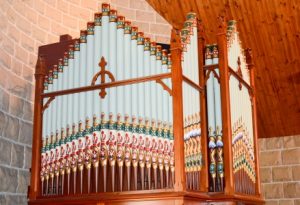 This pipe organ was made in 1881 to the order of St Peter's Anglican Parish, East Sydney. It was installed in St Peter's Church in February, 1882. It was bought by this parish on 8 February, 1993, when St Peter's Parish was amalgamated with the parish of Darlinghurst and St Peter's church was declared redundant.
This pipe organ was made in 1881 to the order of St Peter's Anglican Parish, East Sydney. It was installed in St Peter's Church in February, 1882. It was bought by this parish on 8 February, 1993, when St Peter's Parish was amalgamated with the parish of Darlinghurst and St Peter's church was declared redundant.
The organ was installed in this new church during July, August and September, 1995 by Pitchford & Garside Pty. Ltd. On 15 October 1995, it was inaugurated by Mr Norman Johnston who had been the last organist in St Peter's church and who had used it as a teaching instrument for many years.
The instrument is fully mechanical in its action. It was completely restored in all its parts prior to installation and a new electrically-power blower was installed under it. The organ is now in its original condition. It was classified by the national Trust of Australia on 29 May 1996.
Please remember with gratitude the original donors of St Peter's church and the more recent benefactors principally the late Noel Gibson and the late Fr Patrick Frost whose munificent bequests made the transfer and restoration possible. Also, the Heritage Council of NSW which made grants for the preservation of the instrument while it was in both St Peter's and St Finbar's.
Dual Symbolic Meaning
The designs on the front pipes represents the floral national emblems of England, Ireland, Scotland and Wales namely the rose, shamrock, thistle and look. Wales is represented also by the Prince of Wales' feathers.
The pipes also carry crowns which feature the fleur-de-lis, "flower of the lily". In Christian art the lily is a symbol of chastity and purity attributed to the Virgin Mary. The Angel Gabriel is often represented holding a lily I his hands at the Annunciation.
The lily is evocative of the words of Jesus: "Consider the lilies of the field, how they grow; they neither toil nor spin, yet I tell you, even Solomon in all his glory was not clothed like one of these". Matt. 6:28,29. The lily is sometimes in Christian art identified with the iris which in Greek means "rainbow" and recalls the rainbow given buy God as a sign of reconciliation between God and Man in the story of the flood.
In Christian art the rose has symbolic meanings. The rose depicted on the organ has five petals which represent the five senses;' taste, sight, hearing, smell, and touch through which the spirit of the human being makes contact with the material world. The rose is sometimes qualified as the "rosa mystica" and the "rosa mundi". The former refers to Christ who by sacrifice attains new life in God. The thorns of the rose and the crown of thorns of the Passion Narrative have a connecting double symbolic meaning.
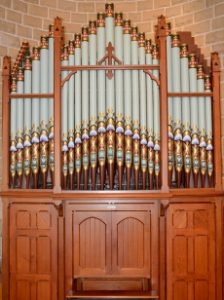 The "rosa mundi", i.e., the rose of the world, refers symbolically to the developing world and the cycle of birth and death that it shows. There is a connection here with the rose window of the cathedrals which were often divided into twelve segments and take for form of a wheel signifying the "wheel of being" and has links with the astrological types. It is in this way that the "rosa mundi" came to be connected with the Blessed Virgin Mary.
The "rosa mundi", i.e., the rose of the world, refers symbolically to the developing world and the cycle of birth and death that it shows. There is a connection here with the rose window of the cathedrals which were often divided into twelve segments and take for form of a wheel signifying the "wheel of being" and has links with the astrological types. It is in this way that the "rosa mundi" came to be connected with the Blessed Virgin Mary.
As the sea is the womb of all life on earth, so is the womb of the Blessed Virgin Mary the origin of the life of Jesus Christ, who in turn by his sacrificial death paradoxically brought the New Life of God to the world. These ancient symbols are still used by contemporary artist such as Arthur Boyd whose painting "Crucifixion and Rose" links together all the points mentioned above.
Donations were given to the appeal for the restoration of the Hele pip organ and its installation in the new St Finbar's church. The fifty front pipes have been restored to their original colours and patterns with which they were decorated when they left the factory in Plymouth, England. They were subsequently painted over in gold paint when fashions changed. The restorer, Peter Clarke, of Merrylands, had to sand back by hand the successive coats of gold paint in order to get to the original patterns. He then began to repaint the designs in their original colours. The average cost was $200 each and parishioners were invited to sponsor a pipe. 1150 pipes in all have been tuned.
Sunday 15 October was fixed for the official inauguration. Mr Norman Johnston, the University of Sydney organist was invited to give a recital on that day. Norman Johnston was the organist at St Peter's Anglican church Woolloomooloo and used the organ as his teaching instrument for many years. It is due to his influence that the organ was kept in good working order.
The Sanctuary
The pulpit, which was so formerly prominent in older churches, was designed in an era when there was no electric sound amplification. Find out more using the button below.
The most fundamental change introduced by the Constitution on the Sacred Liturgy of the Second Vatican Council of 4 December, 1963 and subsequently formalised by the General Instruction Of The Roman Missal, was that the priest should face the people when celebrating Mass.
The implementation of this decree reversed many hundreds of years of contrary practice. While this meant a return to a more ancient practice of the Church it resulted in a very significant re-ordering of both the interior and exterior of churches especially new ones such as ours.
Another significant change introduced by the same Constitution and General instruction was that the Blessed Sacrament was not to be reserved on the principal altar of the church but was to be reserved in a prominent place elsewhere in the church which was accessible and available for private devotion.
The pulpit, which in Roman times meant a stage or scaffold, and which was so formerly prominent in older churches, was designed in an era when there was no electric sound amplification, vast crowds could still be addressed by the unaided human voice. However, very few people could do this.
Again, in Roman times, the Emperors and generals employed a person with a very deep voice, called a 'stentor' to deliver their speeches and announcements. In the middle ages this person was the herald and on the local scene was the town crier. With the introduction of electric sound amplification pulpits are no longer necessary and in contemporary churches have been replaced by the ambo or reading desk and the ministry of proclaiming the scripture in church opened to all, even those with very quiet voices.
This development does not mean that those older churches which have elaborate pulpits should discard them. The stone structure which holds the book is neither a lectern nor a pulpit properly so called. It is more correctly called an ambo.
In keeping with the changes mentioned above, which were inspired by a desire to revert to a much earlier form of Christian worship, it was decreed that the area of the church known as the sanctuary where the liturgical action took place, was not to have any physical barriers such as altar rails or rood screens which would obstruct the view and presence of the people.
The General Instruction of the Roman Missal states that there is a place of the people attending and a place of the priest presiding the areas are not so separate as to seem inaccessible or remote from each other. The sanctuary area, so called, is neither to be too high nor too flat as to seem remote or to be obscured.
The Altar
Although the cross was used symbolically in pre-Christian times, the disciples of Jesus did not use it as a Logo until the fifth century by which time crucifixion as a method of execution has long ceased. Read more below.
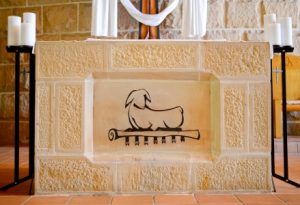 Although the cross was used symbolically in pre-Christian times, the disciples of Jesus did not use it as a Logo until the fifth century by which time crucifixion as a method of execution has long ceased. When the Christians were small, persecuted groups in the towns of the Roman Empire, they preferred to use the lamb, fish and lion as symbols of Christ as these were sufficiently innocuous as not to arouse interest amongst the pagans.
Although the cross was used symbolically in pre-Christian times, the disciples of Jesus did not use it as a Logo until the fifth century by which time crucifixion as a method of execution has long ceased. When the Christians were small, persecuted groups in the towns of the Roman Empire, they preferred to use the lamb, fish and lion as symbols of Christ as these were sufficiently innocuous as not to arouse interest amongst the pagans.
The form of the cross that was adopted took two shapes. Firstly, the so-called Greek cross, which was geometrically perfect, as is the one in this church and the Latin cross which is more adaptable to the shape of the human body. It is most likely that Jesus himself did not die on a cross of either shape but rather on one shaped at a 'T' or even a simple stake.
In pre-Reformation England, churches were built in a cruciform shape and at the centre where the east-west axis intersected the north-south axis a cross symbolic of the death of Christ was placed. The old Anglo-Saxon word for cross was 'rod' and later 'rood'. This was the name of the construction beam in the roof which tied the elements of the walls and roof together. Hence the cross that was hung or placed on this beam became known as the 'rood'.
With the passage of time a screen was also hung from the rood beam to separate the chancel form the nave or as we would say, the sanctuary or place of the priest from the nave or the place of the people. With the passage of time the roods (crosses) and their screens were adorned with the figure of Mary and the beloved disciple and the two thieves.
At the Reformation, and especially in the Puritans, the roods were dismantled in most of the churches of England but under the influence of the Oxford Movement, the Romantic Movement, and the Gothic revival movement in architecture, many Anglican churches replaced the rood screen especially in many parts of Australia where new Anglican churches were erected after 1850.
The word 'cross' which is derived from the Latin 'crux' gradually supplanted the Anglo-Saxon word 'rod' or 'rood' as the English language developed. The Latin form of the word cross has a root in the ancient original Aryan language. This root word is 'ker' meaning to grow and it finds its modern equivalent in our word 'create'. The simple cross is an image formed by two intersecting straight lines and is tied in with the duality of the created universe as we experience it.
Many interpretations have been placed on the cross as a sign long before, by coincidence, as it were, Jesus Christ was put to death on an instrument of that shape. But subsequently Christian iconographers and mystics have loved to intertwine the pre-Christian meanings of the sign of the cross with the theological significances of the death of the Messiah on such an instrument.
In this church the two intersecting beams can be understood as eternity for the vertical and time for the horizontal. In this interpretation we can find a meaning for the use of the words, "I am feeling cross today", i.e., frustrated, irritable, etc. The meaning comes from the idea that a human being's eternal nature is pinned in time. In other words human beings feel an internal conflict between the present existence in time and the call of eternity. The solution to the conflict, or anomaly cannot be found in the denial of the one or the other but in a reconciliation of both.
The Gospel of John which is very rich in allusions to Greek, Jewish, and other literary sources has Jesus using the phrase about his being not of this world and of having an eternal glory before the world was created; (John Ch. 17 and following). In these phrases John is using the 'time' and 'eternity' themes tied up in the symbol of the cross on which Christ died. For the evangelist, John, in Christ the Eternal God enters time and viewing the death of Jesus as a sacrifice, by connecting it with the sacrificial offering of the paschal lambs in the Jerusalem Temple at the same time he achieves a reconciliation between the creature of time, 'man' and the creator, 'God'. It is this theme of reconciliation that is behind our use of crosses at the end of letters to signify kisses.
The Cross
The cross in the wall of the church was designed by the famous sculptor, Mr Tom Bass (1916-2010). It portrays the five wounds of Christ from which flowed His most precious Blood. Click the button for more.
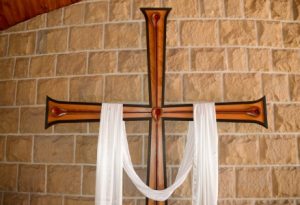 The cross in the wall of the church was designed by the famous sculptor, Mr Tom Bass (1916-2010). It portrays the five wounds of Christ from which flowed His most precious Blood. The Gospel also records that water, too, flowed from the side of Christ. This phenomenon together with other Biblical incidents is depicted in the blue glass of the window adjoining the baptistry. Mr Tom Bass was a deeply religious man who delighted in meditation as a form of prayer. This personal characteristic was clear in his religious art.
The cross in the wall of the church was designed by the famous sculptor, Mr Tom Bass (1916-2010). It portrays the five wounds of Christ from which flowed His most precious Blood. The Gospel also records that water, too, flowed from the side of Christ. This phenomenon together with other Biblical incidents is depicted in the blue glass of the window adjoining the baptistry. Mr Tom Bass was a deeply religious man who delighted in meditation as a form of prayer. This personal characteristic was clear in his religious art.
The essential way in which to pray using an icon is to make eye contact with the icon and then to allow the Spirit to draw one into prayer. The basis of the devotion to the five wounds is found in the New Testament. For example, in Eph. 1:7, "In him was have redemption through his blood, the remission of sins, according to the riches of his grace". After his resurrection Our Lord retained the marks of his wounds as badges of triumph.
From the Gospel of John: "The doors were closed, but Jesus came in and stood among them. 'Peace be with you' he said. Then he spoke to Thomas, 'put your finger here. Look, here are my hands. Give me your hand and put it into my side. Do not be unbelieving any more but believe."
All through Christian history, devotion to the five most precious wounds has been popular. St Bernard, in particular, set the tone for the entire Middle Ages with his famous sermons on this topic.
"The Catholic Encyclopaedia" in an article on this topic states that for John, the evangelist, the resurrection of Christ is not so much the resumption of heavenly glory but Christ's renewal of personal relations with His disciples (for us this takes place in the sacraments. Ed.)
By his emphasis on the wounds, John is demonstrating that the Resurrection is not merely a reality on the spiritual level but is also an event on the temporal historical plane. For John, the events surrounding the raising of Jesus happen in this world and the resurrection begins a new historical era in which the pierced side of Christ continues to pour out sacramental fruits of the redeeming death-resurrection.
When one stands in from of the cross, one could imagine oneself standing as the beloved disciple on Calvary and the doubting disciple Thomas or better still, as one of those of whom Jesus said, "Blessed are they who have not seen and yet have believed."
In addition to the religious significances mentioned above, one can reflect on the figure five itself. In ancient times, the figure five had mystical and sacred meanings. It is particularly related to the five senses: taste, sight, touch, hearing and smell through which human beings relate to the external world. The five senses enable human beings to have consciousness and to achieve a perfection that is comparable to that of God.
The constant struggle to control the stimuli that the five senses carry to the human psyche is a theme that has fascinated all generations. Echoes can be found in contemporary psychology which, following Freud, speaks of the human ego and addresses itself to understanding the interior struggle of the human psyche. In all these themes, spiritual writers see a relationship to the death of Christ and his resurrection. The figure 5 itself carries some of these meanings because on close inspection it can be seen to be a pictograph consisting of a cross surmounting a circle or orb.
The Stained Glass Window
In general the window represents the creative and restorative power of God. The window could be called the resurrection window. Learn more about our stained glass window using the button below.
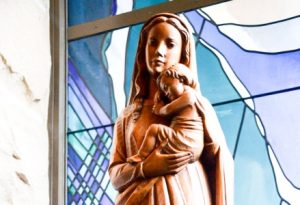 In general the window represents the creative and restorative power of God. The window could be called the resurrection window.
In general the window represents the creative and restorative power of God. The window could be called the resurrection window.
The blue water is reminiscent of Genesis 2: 5-10, "a river flowed from Eden to water the garden, and from there it divided to make four streams".
This theme should recall the original creative power of God. The water theme also recalls Exodus 15: 22-27 and Exodus 17: 1-7 when the people murmured in the desert and put God to the test. Water was provided, when, following God's direction, Moses struck the rock.
The theme is that God provides for his people.
Other Symbols
We think of things as being new when we have not experienced them in our lifetime, which is quite reasonable. Learn more about symbols as well as the Ambo, Chair and Altar.
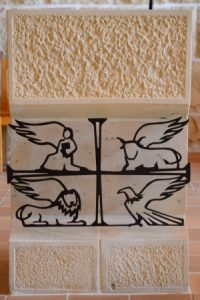 We think of things as being new when we have not experienced them in our lifetime, which is quite reasonable.
We think of things as being new when we have not experienced them in our lifetime, which is quite reasonable.
But when we look at the same things from the perspective of 2000 years of church history, we often find that they are not so new after all.
Why is the priest's chair in the centre of the sanctuary? Well, if you are setting about arranging things on the sanctuary, you do not start with the priest's chair.
A good starting point is one of the documents of Vatican II, the Dogmatic Constitution on Divine Revelation, 'Dei Verbum', n.21:
"The Church has always venerated the divine Scriptures just as she venerates the body of the Lord, since from the table of both the word of God and of the body of Christ, she unceasingly receives and offers to the faithful the bread of life, especially in the sacred liturgy."
This idea that the Sacred Scripture and the body of Christ should be venerated equally will perhaps come as a shock to those of us who come in late for Mass, somehow believe (mistakenly) that the readings from Scripture, the Liturgy of the Word, is a preliminary action that is of little importance.
Contrast this with the view of a writer in the 6th Century, Caesarius of Arles: "The one who is negligent in hearing the word of God is no less guilty than the one who, through carelessness allows the body of Christ to fall to the floor."
Therefore, the altar, upon which Christ becomes present in his body and blood, and the ambo, or lecturn, from which his presence in his word is proclaimed, are of similar material and given equal prominence. That done, it is fitting to have the priest, in his role of presiding over the whole liturgical action - word, sacrament, community - in the central position.
Ambo, Chair & Altar
Ezekiel 1:5-26 and Revelation 4:6-7 describe four living creatures serving before the throne of God, having faces of a man, of a lion, of an ox, and of an eagle. Matthew's Gospel often uses the title 'Son of Man' and it tells us a lot about Christ's humanity. Mark's writing is direct and straight to the point, like a lion.
Luke gives us the account of the stable in Bethlehem, with special mention of the ox. John's Gospel is distinct from the other three, and stresses the relationship of Jesus with his Father, looking beyond our earthly status as does an eagle from the heights above. So the four symbols on the ambo of man, lion and eagle represent the four evangelists.
To summarise:
Evangelist Symbol
Matthew (Man)
Mark (Lion)
Luke (Ox)
John (Eagle)
The front of the altar suggests a reference to Revelation 5:5-10 - the Lamb of sacrifice has been found worthy to receive the scroll and break open the seven seals.
The Blessed Sacrament
At the Last Supper, Jesus said: "Do this in commemoration of me." Click the button below to learn more about the Blessed Sacrament and our church.
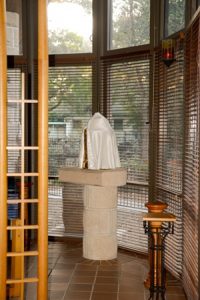 At the Last Supper, Jesus said: "Do this in commemoration of me."
At the Last Supper, Jesus said: "Do this in commemoration of me."
The 'this' to which he referred was the action which is the Mass; he did not refer to the reservation of the Blessed Sacrament, as such.
However, from the earliest times it has been the practice to reserve the sacrament for the needs of the sick and the dying; having reserved it, it was duly venerated.
But should it be reserved where Mass is celebrated? Going again to Vatican II, the Constitution on Sacred Liturgy, Sacrosanctum Conilium, n. 7, speaks of the fourfold presence of Christ in the Mass.
"'He is present in the sacrifice of the Mass, not only in the person of his Minister … but especially under the Eucharistic species. He is present in his word, since it is he Himself who speaks when the Holy Scriptures are read in the church.
"He is present, finally, when the Church prays and sings, for He promised: "Where two or three are gathered together for my sake, there am I in the midst of them" (Mt. 18:20)'."
A fifth presence, in an adjacent tabernacle, from consecration at a previous Mass is, to say the least, confusing, and must distract attention from the action where we are trying to give effect to His instruction to do 'this'.
It is far preferable to reserve the Blessed Sacrament where it can be properly venerated in private prayer.
Ministries
ADMINISTRATION
Parish Priest
Fr Joseph Lam OSA 0490 148 387
Parish Staff 4742 6958
Secretary: Juliana Khnouf
Administration & Finance: Peter McMahon
Office Hours 9:30am to 3pm.
Parish Pastoral Council (PPC)
Members are appointed or elected parishioners for a three year period. Their role is to advise the Parish Priest and help him discern and administer the parish.
Ensures Parish Priest and parishioners are well informed of all current and future parish pastoral and financial requirements.
Contact Vince Dobson 4739 1376
Current Pastoral Council Members
Vince Dobson, Martin Rogers, Colleen Fuller, Jim McLoughlin, Ann O'Connor, Carl Moll, Jesse Mowbray, John De Mattia, Donna McFadzean, Juliana Khnouf.
Parish Finance Committee (PFC)
Members are chosen to advise the Parish Priest in matters concerning the financial management and administration of Parish temporal goods.
Contact Carl Moll 0417 471 137
Information Technology and Audio Visual Committee
Develops and displays audio visuals for our weekend, Easter and Christmas liturgies, and maintains a database of these slides.
Contact Pat Watson 4739 4986
Working with Children
Carries out the legal procedures involved where staff and volunteers work closely with children.
Contact Peter McMahon 0404 010 997
Cashiers
Count and record the weekend collections.
Rostered for 1-2 hours on a weekday.
Contact: Parish Office 4742 6958
Church Care Teams
Clean church weekly and on special occasions. Teams of 4-5 are rostered about once every three months.
Contact Heather Lee 4739 4906
Buildings, Gardens and Maintenance
Volunteer parishioners do maintenance and run working bees.
Contact Tony Doyle 4739 3400
SOCIAL
St Finbar's Netball Club
Fosters parish participation in netball games in the local Saturday competition
Contact Janette Ankers 4739 4745
Bridge Club
Fosters the game of Bridge on a regular basis for all members of the community.
Contact Frank Fitzpatrick 4753 6048
Indoor Bowls Club
Provides light-hearted social interaction over a game of bowls each Friday afternoon
Contact Jim Pope 4739 3524
Liturgy Committee
Meets regularly to assist the Parish Priest with the planning and implementation of Parish Worship.
It supports those involved in liturgical ministries and encourages ongoing liturgical formation for parishioners.
Contact Terry Keogh 0429 393 090
Liturgical Rosters
Prepares the rosters for Welcomers, Wardens, Sacristans, Senior Servers, Junior Servers, Readers, Presentation of the Gifts, Ministers of Holy Communion and Cashiers, to ensure careful preparation and conduct of Parish Liturgies.
Contact Parish Office (Juliana) 4742 6958
Music Groups
Prepare the music for Sunday liturgical celebrations and for Christmas and Easter.
Provide a variety of musical styles through folk groups, organ and cantors and children's choir.
Contact Melissa McDonald 0408 693 042
Sacristan
Cares for the sacred vessels and vestments. Sets up before Mass and otherliturgies and tidies up afterwards. Attends to the details of the liturgy so the celebration flows smoothly.
Contact Peter McMahon 0404 010 997
Senior Server
Assists the priest during the celebration of Mass and at the distribution of Holy Communion.
Contact Peter McMahon 0404 01 09 97
Junior Server
Assists the priest and Senior Server at Mass.
Need to have completed the sacraments of Reconciliation and Eucharist.
Contact Peter McMahon on 0404 010997
Welcomer
Greets attendees, especially new parishioners and visitors, on behalf of the St Finbar's Community and ensures they are made welcome.
Contact Parish Office (Juliana) 4742 6958
Warden
Checks roster to ensure all ministers are present, finds replacements if necessary, takes up collections, attends to security, ushers late arrivals, manages the wardens table and responds to enquiries.
Contact Parish Office (Juliana) 4742 6958
Reader
Proclaims the Word of God with clarity.
Leads the Prayers of the Faithful.
Contact Parish Office (Juliana) 4742 6958
Presentation of the Gifts
Present the gifts of bread and wine for consecration on behalf of the Assembly.
Contact Parish Office (Juliana) 4742 6958
Ministers of Holy Communion
Assist the priest in the distribution of the Body & Blood of Jesus Christ during Mass.
They may also choose to be available to take the Blessed Sacrament to the sick and housebound.
Contact Parish Office (Juliana) 4742 6958
Children's Liturgy on Sundays
Offers children the opportunity to hear the First Reading and Gospel at an age appropriate level.
Offered only during school terms at the 9:30am Mass for children in Kinder to Year 6.
Contact Michelle Santoro 4739 8869
Piety Stall Team
Sells religious items after Sunday Masses.
Contact Noreen Taylor 4739 8882
Organ and Concert Committee
Organises special concerts in our church.
Organises the maintenance of our heritage organ and raises funds to help cover this maintenance.
Contact Judy Burrett 4754 1780
Christmas and Easter Invitations Group
Prepares and organises distribution throughout the parish area of the invitations to the Christmas and Easter ceremonies.
Contact Todd Stanford 4739 5719
Emergency Contact Numbers
To notify of serious illness requiring the
Visitation Team: Marie Hurley 4739 2389
To seek help at time of loss call the
Bereavement Team: Margaret Richards 4739 6470
and/or the Parish Priest Fr Joseph Lam 0490 148 387
Pastoral Care Team
Seeks to help those in need through sickness, crisis, loneliness, grief and loss, separation, frailty or isolation.
Visits the elderly, sick, housebound or isolated.
Organises anointing and Communion to the sick and housebound, and anointing of the sick at a Mass, usually at 10am on third Thurrsday of each month.
Informs the Parish Priest of the pastoral needs of the community.
Liaises with St Vincent de Paul and the St. Finbar's school pastoral care group.
Offers spiritual, liturgical and practical support to those suffering grief and loss through death, divorce, separation and other significant losses in life.
Reconnects with grieving families at the annual All Souls Mass.
Contact Margaret Richards 4739 6470
Bereavement Team
Offers spiritual, liturgical and practical support to those suffering grief and loss through death, divorce, separation and other significant losses in life. Activities include visitation, liturgical support and funeral preparation. The team reconnects with grieving families at the annual All Souls Mass.
Contact Margaret Richards 4739 6470
Youth Group
Come to make friends, share your skills and reflect on your Christian life.
Primary school group meets at 5pm before Mass on 1st Sundays.
High school group meets at 7:30pm after Mass on 1st and 3rd Sundays.
Contact Claire Brown 0432 599 570
Playgroup for Preschoolers
Children learn through friendly, creative, happy play.
Mums, Dads, grandparents and their children 0 to 5 are welcome on a regular or casual basis.
Meets on Wednesday mornings for two hours from 9.30am.
Contact the parish office on 4742 6958
Hospitality
Provides hospitality after 9:30am Mass each Sunday, after special parish events, and at Easter, Christmas and on special occasions.
Contact Lina Wiecek 4739 3817
St Vincent de Paul Conference
Helps people in need, provides food parcels and vouchers, friendly advice and other assistance when necessary.
Supports the Conferences in India and Indonesia.
Meets on alternate Mondays at 5pm
For membership enquries contact Garry Pursehouse via the Parish Office 4742 6958
For Family Assistance Contact 1800 606 724
St Finbars School
Phone: 4724 3600 Fax: 4739 8153
Principal: Robyn Clarke.
Email: rclarke7@parra.catholic.edu.au
Provides a Catholic education to approximately 350 children.
Has a pastoral care group, school community group, social & fundraising group & a fete committee.
Catechists
Accept the responsibility to bring the message of the Gospel to state school children.
Teach approx 300 primary students each week in the state schools.
Training, lesson plans and workbooks are provided by the parish and the diocese.
Contact Beth Culliver 0408 317 086
Baptism
Assist Parish Priest and families to prepare their children (up to age 6) for Baptisms, normally on 2nd & 4th Sundays at 11am.
Preparation includes an evening presentation on Baptism and a practical guide to the stages of the Sacrament.
Contact Parish Office (Juliana) 4742 6958
Sacramental Program Team
Prepares children & their families for the Sacraments of Reconciliation, Confirmation and Eucharist in small groups of parents and children, led by facilitators.
Contact Jim or julie-Ann 0481 862 785
Lenten Groups
Gather in small groups for the 5 week Lenten period for a guided discussion program.
Choice of groups with differing ages, interests, meeting times and locations.
Contact Mila Svehla 4739 1470
Rite of Christian Initiation of Adults (RCIA)
Facilitates the process of initiation into full membership of the Catholic Church for non-Catholic adults.
Meets in a small group for prayer, discussion, questioning, guided talks, workshops, scripture study, and ceremonies.
Contact Margaret Richards 4739 6470
Rite of Christian Initiation for Children (RCIC)
Is for children 7 or older who want to be initiated into the Catholic Church.
Similar to the adult program.
Candidates usually join other children preparing for Confirmation and Eucharist.
Contact Parish Office (Juliana) 4742 6958
Marriage
Engage is an exciting marriage formation program, aiming to provide education in relationship skills, spiritual formation for the sacrament of marriage and emotional support for the engaged couple. Preparation is carried out in small groups for six sessions led by married couples from our parish.
Contacts Parish Office 4742 6958
